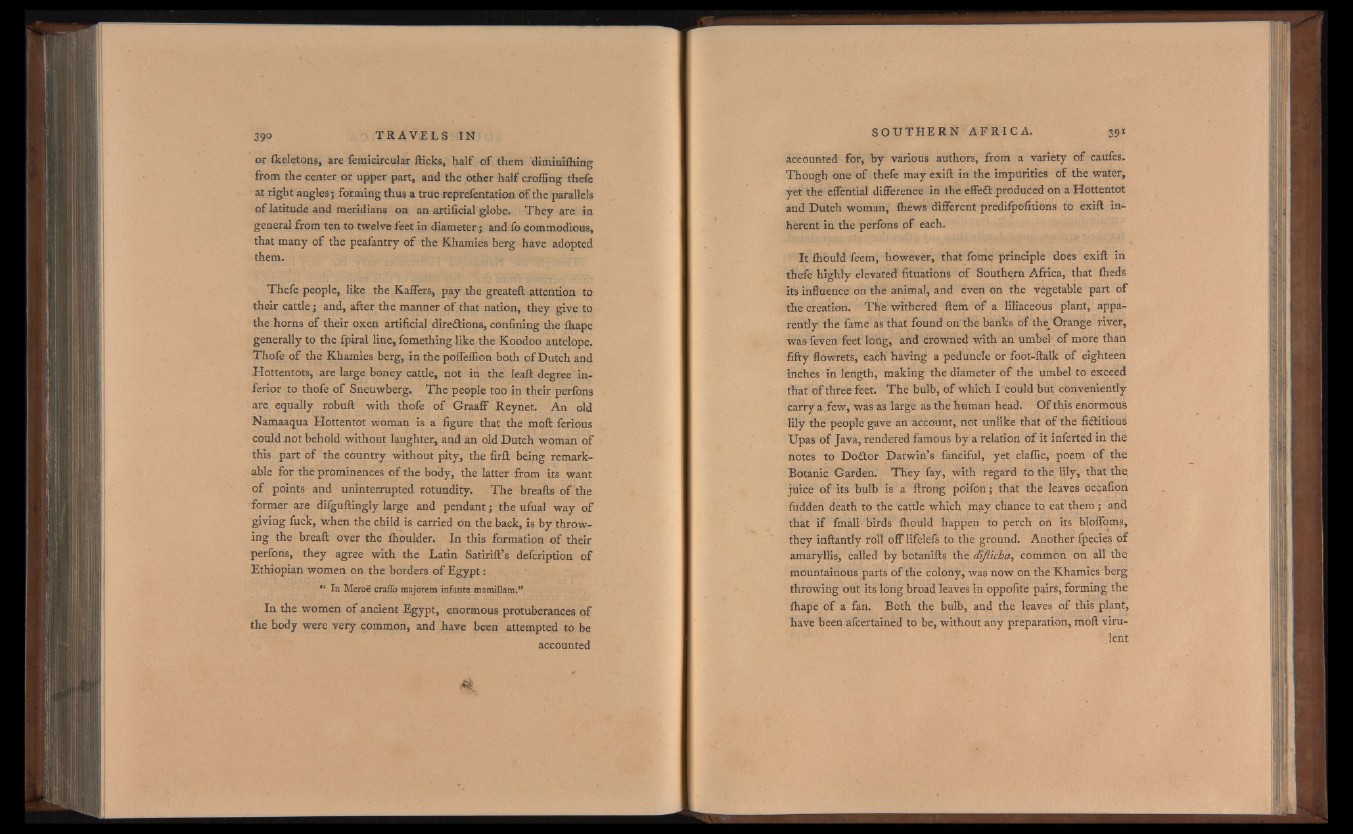
or ikeletons, are femicircular fticks, half o f them dimini ihing
from the center or upper part, and the other half croffing thefe
at right angles; forming thus a true reprelentation o f the parallels
of latitude and meridians on an artificial globe. They are in
general from ten to twelve feet in diameter; and lb commodious,
that many o f the peafantry o f the Khanties berg have adopted
them.
Thefe people, like the Kaffers, pay the greateft attention to
their cattle; and, after the manner o f that nation, they give to
the horns of their oxen artificial diredions, confining the lhape
generally to the fpiral line, fomething like the Koodoo antelope.
Thofe o f the Khamies berg, in the poffeffion both o f Dutch and
Hottentots, are large honey cattle, not in the leaft degree inferior
to thofe o f Sneuwberg. The people too in their perfons
are equally robuft with thofe of Graaff Reynet. An old
Namaaqua Hottentot woman is a figure that the moft ferious
could not behold without laughter, and an old Dutch woman o f
this part of the country without pity, the firft being remarkable
for the prominences o f the body, the latter from its want
o f points and uninterrupted rotundity. The breafts o f the
former are difguftingly large and pendant; the ufual way o f
giving fuck, when the child is carried on the back, is by throwing
the breaft over the Ihoulder. In this formation of their
perfons, they agree with the Latin Satirift’s defcription of
Ethiopian women on the borders o f Egypt:
“ In Meroe craflo majorem infante m a mil lam.”
In the women o f ancient Egypt, enormous protuberances o f
the body were very common, and Lave been attempted to be
accounted
accounted for, by various authors, from a variety o f caufes.
Though one of thefe may exift in the impurities of the water,
yet the effential difference in the effeCt produced on a Hottentot
and Dutch woman, fhews different predifpofitions to exift inherent
in the perfons o f each.
It fhould feem, however, that fome principle does exift in
thefe highly elevated fituations o f Southern Africa, that iheds
its influence on the animal, and even on the vegetable part o f
the creation. Th'e withered ftem of a liliaceous plant, apparently
the fame as that found on the banks of the Orange river,
wasfeven feet long, and crowned with an umbel of more than
fifty flowrets, each having a peduncle or foot-ftalk of eighteen
inches in length, making the diameter of the umbel to exceed
that of three feet. The bulb, of which I could but conveniently
carry a few, was as large as the human head. O f this enormous
lily the people gave an account,, not unlike that of the fiftitious
Upas of Java, rendered famous by a relation of it inferted in the
notes to Do£tor Darwin’s fanciful, yet claflic, poem of the
Botanic Garden. They fay, with regard to the lily, that the
juice of its bulb is a ftrong poifon; that the leaves occafion
fudden death to the cattle which may chance to eat them; and
that if fmall birds fhould happen to perch on' its bloffoms,
they inftantly roll off lifeleis to the ground. Another fpecies of
amaryllis, called by botanifts the dtfiicba, common on all the
mountainous parts of the colony, was now on the Khamies berg
throwing out its long broad leaves in oppofite pairs, forming the
fhape of a fan. Both the bulb, and the leaves of this plant,
have been afcertained to be, without any preparation, moft virulent